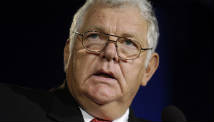For the past week, leadership at the National Rifle Association has largely stayed away from the media, but this morning the group may weigh in on how to keep a deadly shooting massacre like last week's at a Newtown, Conn., elementary school from happening again.
The NRA will hold a news conference in Washington, D.C., just before 11 a.m.
Its leadership has held off on interviews this week after refusing to appear on Sunday morning public affairs shows this past weekend.
The group came under pressure after Adam Lanza, 20, killed 20 children and six adults before shooting himself at Sandy Hook Elementary School in Newtown last Friday.
"Out of respect for the families, and as a matter of common decency, we have given time for mourning, prayer and a full investigation of the facts before commenting," the group said in a press release Tuesday. "The NRA is prepared to offer meaningful contributions to help make sure this never happens again."
NRA News anchor Ginny Simone said Thursday that in the wake of the Sandy Hook shooting, membership surged "with an average of 8,000 new members a day."
New York City Mayor Michael Bloomberg has said the NRA is partially to blame for the tragedy.
"We're not trying to take away your right to advance the interests of gun owners, hunters, people who want to protect themselves," Bloomberg told "Nightline" anchor Cynthia McFadden in an interview Thursday. "But that's not an absolute right to encourage behavior which causes things like Connecticut. In fact, Connecticut is because of some of their actions."
Christian Gooden/St. Louis Post-Dispatch/AP Photo
President Obama Launches Gun-Violence Task Force Watch Video
President Obama on Gun Control: Ready to Act? Watch Video
Joe Biden to Lead Task Force to Prevent Gun Violence Watch Video
The guns used in the attack were legally purchased and owned by the shooter's mother, Nancy Lanza, who Adam Lanza shot to death before his assault on the school.
In the aftermath of the shooting, many, including Bloomberg, have called for stricter regulations on the type of weapons used in this and other instances of mass gun violence this year.
Sen. Dianne Feinstein, D-Calif., has said she intends to introduce a bill banning assault weapons on the first day of next year's Congress -- a step the president said he supports.
President Obama announced Wednesday that Vice President Joe Biden will head a task force of leaders from across the country that will evaluate the best solutions to reduce gun violence in the United States.
Obama said he will "use all the powers of this office to help advance efforts aimed at preventing more tragedies like this."
Mayors Against Illegal Guns, of which Mayor Bloomberg is co-chair, released a letter to President Obama signed by more than 750 mayors calling on him to produce a plan to "make it harder for dangerous people to possess guns."
The letter asked for mandatory background checks for gun buyers, a ban on high-capacity rifles and ammunition magazines, and a designation of gun trafficking as a federal crime.
ABC News' George Stephanopoulos looked at whether strict gun control laws like those that have worked for the United Kingdom and Japan could work for the U.S. on "Good Morning America" Thursday.
Others have argued that, rather than banning guns, the government should be arming teachers and administrators in schools so that they can defend students in the event of another school shooting.
While Michigan Gov. Rick Snyder vetoed a measure that would have let guns into schools on Tuesday, Texas Gov. Rick Perry and Virginia Gov. Bob McDonnell praised the idea.
Speaking on the NRA's daily news program Tuesday, Dave Koppel of the Independence Institute said the teachers at Sandy Hook should have had weapons.
"We'd certainly be talking about fewer innocent people and children dead," Koppel said.
While a national debate over the necessary solutions to prevent a tragedy of this nature from ever happening again wages on, Connecticut residents will have to wait "several months" before the final Connecticut State Police report on the Newtown shootings is complete.












